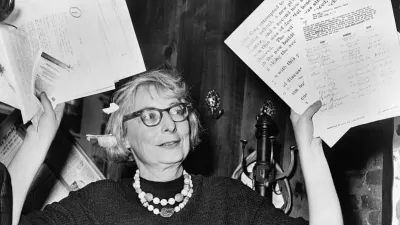The machine-city envisioned by Le Corbusier, and made into practice in decades of modernist bureaucracy, has ultimately produced, according to Simon Richards' essay, an antisocial environment, against which urban planning seems to be now reacting.
"Why is socializing in cities taken to be a good thing? Why do we assume it is beneficial for people to experience urban variety, opportunity, and intrigue? These are not questions normally asked, and it feels perverse to frame them as questions. Still, we have not always been so sure about socializing in cities. We have forgotten the negative argument - that the unregulated social life of large cities is a corrupting influence best avoided. It had never occurred to me to raise these questions until I began research on Le Corbusier. At the same time that he is celebrated as the visionary architect of such modernist masterpieces as the Villa Savoye (1928) and the pilgrimage chapel at Ronchamp (1955), he is decried as an irresponsible and perhaps mentally disturbed city planner. In his Plan Voisin from 1925, for example, Le Corbusier proposed to demolish the center of Paris and replace it with towers in parkland. The prospect of German cities bombed flat by the Allies during World War II made him envious - the Germans were able to rebuild from ground zero. (Incidentally, many British planners offered thanks to the Luftwaffe for returning the favor.) He made plans that would mean (as he put it himself) the "Death of the Street." In proposing the elimination of side alleys and shops, in granting limited space for cafés, community centers, and theaters, in dispersing them over great distances, and constructing them of uninviting concrete, glass, and steel, Le Corbusier expressed his contempt for the teeming hubbub that urbanists now esteem "
Thanks to Alessandro Busa'
FULL STORY: The Antisocial Urbanism of Le Corbusier

Planetizen Federal Action Tracker
A weekly monitor of how Trump’s orders and actions are impacting planners and planning in America.

Maui's Vacation Rental Debate Turns Ugly
Verbal attacks, misinformation campaigns and fistfights plague a high-stakes debate to convert thousands of vacation rentals into long-term housing.

Restaurant Patios Were a Pandemic Win — Why Were They so Hard to Keep?
Social distancing requirements and changes in travel patterns prompted cities to pilot new uses for street and sidewalk space. Then it got complicated.

In California Battle of Housing vs. Environment, Housing Just Won
A new state law significantly limits the power of CEQA, an environmental review law that served as a powerful tool for blocking new development.

Boulder Eliminates Parking Minimums Citywide
Officials estimate the cost of building a single underground parking space at up to $100,000.

Orange County, Florida Adopts Largest US “Sprawl Repair” Code
The ‘Orange Code’ seeks to rectify decades of sprawl-inducing, car-oriented development.
Urban Design for Planners 1: Software Tools
This six-course series explores essential urban design concepts using open source software and equips planners with the tools they need to participate fully in the urban design process.
Planning for Universal Design
Learn the tools for implementing Universal Design in planning regulations.
Heyer Gruel & Associates PA
JM Goldson LLC
Custer County Colorado
City of Camden Redevelopment Agency
City of Astoria
Transportation Research & Education Center (TREC) at Portland State University
Jefferson Parish Government
Camden Redevelopment Agency
City of Claremont





























